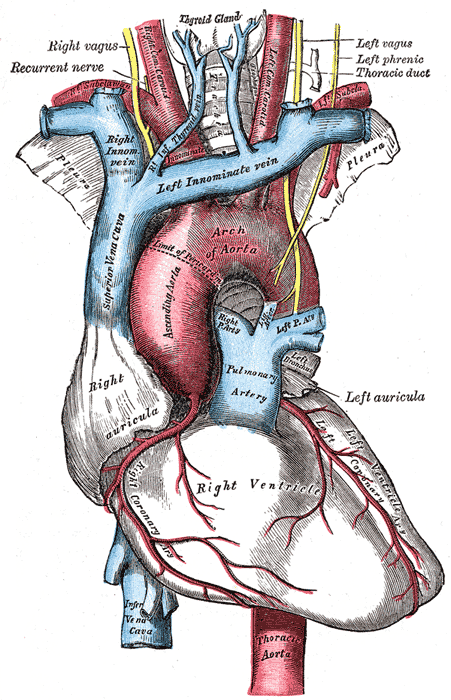
Updated January 2, 2022
The heart is an integral organ in the human body. It is made of specialized cells that contract in response to its own electrical conductance system, keeping the blood flowing through the body. The blood carries oxygen and nutrients to every cell – returning waste products to the lungs and kidney for excretion and exhalation.
When the heart cannot function normally, the entire body suffers, and may even die. Heart disease has been the leading cause in both the United States and worldwide for most of the 21st century (see World Health Organization and U.S. Centers for Disease Control for mortality statistics). Many specific disorders fall under the umbrella of heart disease, including hypertension and congenital valve disorders, but the most common form is ischemic heart disease, a lack of blood to the heart tissue itself. In the U.S., 13 million people are estimated to have coronary artery disease.
| Type | General Cause | Result | Common Treatment |
| Congenital heart disease | Problem with fetal heart development | Depends on exact defect – lack of oxygen, death, kidney dysfunction | Dependent on exact defect – corrective surgery, transplant, no treatment |
| Pericarditis/pericardial effusion | Infection or inflammation of the sac around the heart | Scarring and restriction of the heart | Anti-inflammatories, other drugs as needed, surgery |
| Cardiomyopathy | Primary defect in the heart muscle | Reduced function | Depends on the exact defect and result – transplant, surgery, drugs |
| Valve disorders | Infection, trauma, congenital, other heart disease | Shortness of breath, reduced heart efficiency, dizziness | Transplant, medications, preventing exacerbation |
| Rhythm disorders (e.g., afib) | Electrical system dysfunction, other heart disease | Depends on exact dysfunction – chest pains, palpitations, death | Depends on exact dysfunction – pacemaker, transplant, medication |
| Coronary artery disease | Atherosclerosis, clots | Heart attack (myocardial infarction) | Diet, lifestyle, medications, surgery |
| Ischemic heart disease | Atherosclerosis, scarring/trauma, clots | Stroke (cerebral infarction), ischemia in tissue/organs | Depends on affected vessels – surgery, medication, lifestyle |
Hypertension and heart disease

Hypertension is a consistent increase in arterial pressure and causes secondary organ dysfunction, particularly of the heart and kidneys.
Hypertension can cause the heart muscle to work harder, resulting in cardiomegaly (enlarged heart, e.g., ventricular hypertrophy as seen above) and other cardiomyopathies. Eventually the heart can no longer compensate for the effects on efficiency and heart failure ensues.
Hypertension is generally caused by a combination environmental and genetic factors.
The risk of hypertension and subsequent heart disease can be reduced by reducing dietary sodium and cholesterol intake (atherosclerosis is sometimes associated with increased blood pressure), exercising, maintaining a healthy weight, and avoiding smoking and excessive alcohol intake. Genetic factors can be controlled with medications, such as ACE inhibitors and angiotensin receptor blockers (ARBs), which act on the renin-angiotensin system, a major physiological hormone system involved in responding to the body’s need for adjustments in blood pressure.
Role of cholesterol in heart disease
Coronary artery disease occurs when the supply of blood to the outer layer of the heart is inhibited or when those vessels are damaged. Blockage of the coronary arteries prevents oxygen and nutrients from reaching the outer portion of the heart and the resulting damage is referred to as a heart attack (known as myocardial infarction, or MI).
Having high cholesterol levels, particularly those of LDL type, can cause blood vessel damage and lead to heart disease when other factors are present. These factors include smoking, obesity, family predisposition and genetics including homocysteinuria, hypertension, and diabetes.
Cholesterol is made by the liver as well as being part of a healthy dietary intake of fats. Excess cholesterol is deposited in the blood vessels.
These cholesterol-laden plaques often develop over decades and are a common and normal occurrence in aging blood vessels. The hardening of the arteries and their obstruction, including that leading to a heart attack, is called atherosclerosis. Plaque development begins in youth and is enhanced by environmental or genetic factors as a person ages – the livers of some patients produce too much cholesterol, hypertension increases the stress put on the plaques and vessels, and obesity and diet increase fatty acids that perpetuate plaque buildup, to name a few.
The atherosclerotic plaques become a danger when they obstruct blood flow, rupture, or wear away the arterial wall. The event can go unnoticed or result in a severe complication, such as a heart attack, stroke, or hemorrhage. Plaques can also cause arterial walls to become worn and tear, leading to aneurysms. Clinical manifestations or complications of atherosclerosis are usually not seen until middle age. The clinical phase is more common in men, but begins to appear as frequently in women after menopause.

Disclaimer: This page is for informational and learning purposes only. It is not meant to diagnose or treat any medical condition and should not be used in place of speaking with a medical doctor or seeking treatment.
Aliconia Publishing, LLC and the author make any and all attempts to ensure the accuracy of the presented facts. If you find an issue with any information on these pages, please use the Contact page to alert us. The content is subject to change based on new information or to be updated with additional facts. The date of last change is stated under the main header.
Discover more from Just Facts
Subscribe to get the latest posts sent to your email.